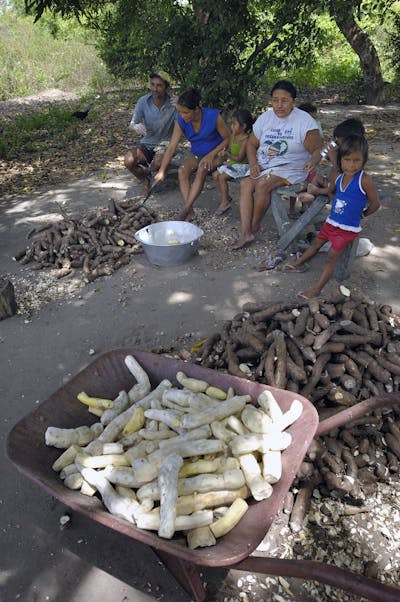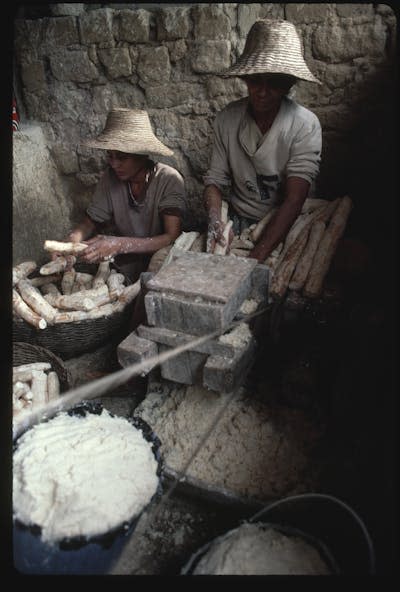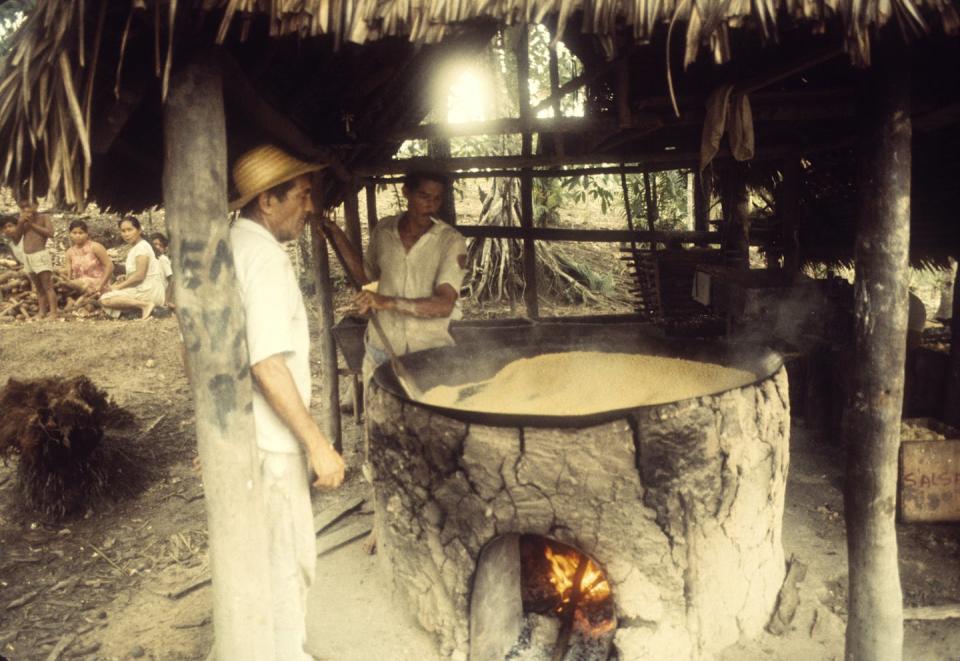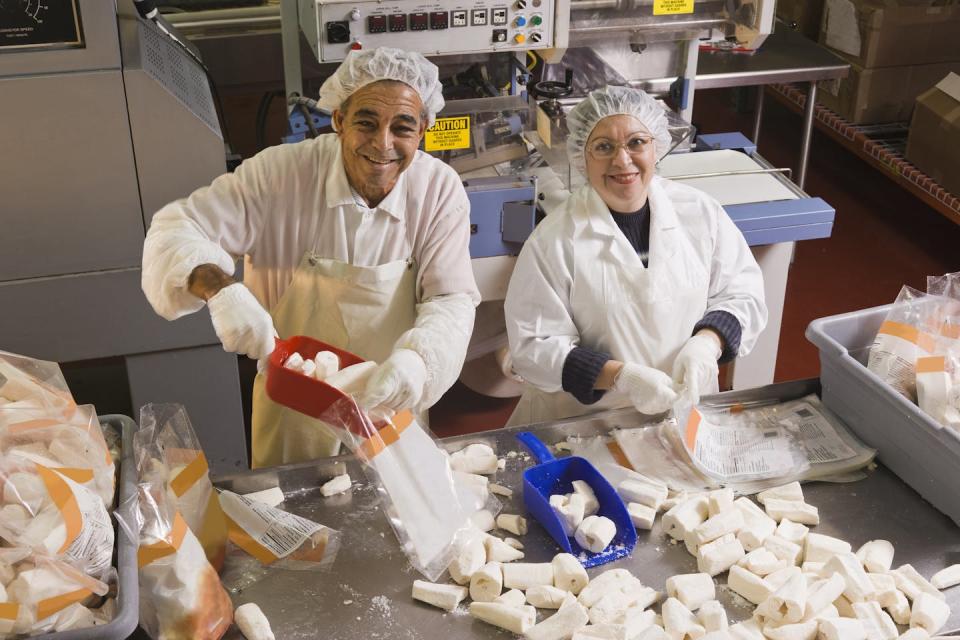The three staple crops that dominate the modern diet—corn, rice, and wheat—are familiar to Americans. The fourth place, however, is occupied by an outsider: cassava.
Although cassava is virtually unknown in temperate climates, it is an important food source in the tropics. It was domesticated 10,000 years ago on the southern edge of the Amazon basin in Brazil and spread throughout the region. With a lanky trunk several meters high, a handful of thin branches and modest, palmate leaves, it looks unremarkable. However, cassava’s unassuming appearance belies an impressive combination of productivity, hardiness and diversity.

Over thousands of years, indigenous peoples have developed the plant from a weedy wild plant into a crop that stores enormous amounts of starch in potato-like tubers, thrives in the poor soils of the Amazon and is virtually immune to pests.
The many benefits of cassava seem to make it the ideal crop. But there is a problem: cassava is highly poisonous.
How can cassava be so toxic yet dominate diets in the Amazon? It’s all thanks to the ingenuity of indigenous people. For the past 10 years, my collaborator, César Peña, and I have studied cassava gardens along the Amazon and its many tributaries in Peru. We’ve discovered dozens of cassava varieties, growers using sophisticated breeding strategies to control its toxicity, and elaborate methods for processing the dangerous but nutritious product.
Long history of plant domestication
One of the biggest challenges early humans faced was getting enough to eat. Our ancestors relied on hunting and gathering, catching prey on the run and gathering edible plants at every opportunity. They were amazingly good at it. So good that their populations skyrocketed, shooting out of Africa, the birthplace of humanity, by 60,000 years ago.
Still, there was room for improvement. Searching the landscape for food burns calories, the very source that is sought. This paradox forced hunter-gatherers to make a choice: burn calories searching for food or save calories by staying home. The trade-off was nearly insurmountable, but people found a way.
Just over 10,000 years ago, they took the hurdle with one of the most transformative innovations in history: the domestication of plants and animals. Humans discovered that plants and animals no longer needed to be hunted if they were tamed. And they could be selectively bred to produce larger fruits and seeds and firmer muscles to eat.
Cassava was the champion domesticated plant of the Neotropics. After its initial domestication, it spread throughout the region, reaching as far north as Panama within a few thousand years. Growing cassava did not entirely eliminate the need for people to forage for food in the forest, but it did lighten the burden and ensured an abundant, reliable food supply close to home.
Today, almost every family in the Amazonian countryside has a garden. Visit any household and you’ll see cassava roasting on the fire, toasting into a chewy flatbread called casabe, fermenting into a beer called masato, and steaming in soups and stews. Before cassava was used in these roles, however, people had to figure out how to deal with its toxicity.
Processing a poisonous plant
One of cassava’s main strengths, its resistance to pests, is provided by a powerful defense system. The system relies on two chemicals produced by the plant, linamarin and linamarase.
These defensive chemicals are found in cells in the leaves, stems and tubers of the cassava plant, where they normally sit still. However, when the cassava cells are damaged, such as by chewing or crushing, the linamarin and linamarase react, releasing an explosion of harmful chemicals.
One of these is notorious: cyanide gas. The explosion also contains other nasty substances, including compounds called nitriles and cyanohydrins. Large doses of these are deadly, and chronic exposure permanently damages the nervous system. Together, these toxins repel herbivores so well that cassava is nearly immune to pests.
No one knows how humans first solved the problem, but the ancient inhabitants of the Amazon devised a complex, multi-step detoxification process that transforms cassava from inedible to delicious.


It begins with the grinding of the starchy roots of cassava on shredding boards studded with fish teeth, bits of stone or, most commonly these days, a rough tin sheet. Shredding mimics the chewing of vermin, releasing the root’s cyanide and cyanohydrins. But they float away into the air, not into the lungs and stomach as they do when eaten.
The shredded cassava is then placed in rinsing baskets where it is rinsed, squeezed by hand and drained repeatedly. The action of the water releases more cyanide, nitriles and cyanohydrins, and the squeezing washes them away.
Finally, the resulting pulp can be dried, which detoxifies it even further, or boiled, which completes the process using heat. These steps are so effective that they are still used in the Amazon, thousands of years after they were first conceived.


A vigorous crop ready to spread
The traditional Amazonian methods of grinding, rinsing, and boiling are an advanced and effective way to turn a poisonous plant into a meal. Yet the Amazonians went one step further and tamed it into a truly domesticated crop. In addition to inventing new methods of processing cassava, they began to track and selectively breed varieties with desirable traits, gradually creating a constellation of species used for various purposes.
During our travels we have found over 70 different varieties of cassava that are very diverse, both physically and nutritionally. They include varieties that vary in toxicity, some that require laborious shredding and rinsing, and others that can be cooked as is but not eaten raw. There are also varieties with different tuber sizes, growth rates, starch production and drought tolerance.
Their diversity is prized, and they are often given imaginative names. Just as American supermarkets sell apples called Fuji, Golden Delicious, and Granny Smith, Amazon gardens sell cassavas called bufeo (dolphin), arpón (harpoon), motelo (turtle), and countless others. This creative breeding has cemented cassava’s place in Amazonian cultures and diets, ensuring its manageability and utility, just as the domestication of corn, rice, and wheat has cemented their place in cultures elsewhere.
Although cassava has been native to South and Central America for millennia, its story is far from over. In the era of climate change and increasing sustainability efforts, cassava is emerging as a potential global crop. Its durability and resilience make it easy to grow in varying environments, even when soils are poor, and its natural resistance to pests reduces the need to protect it with industrial pesticides. Furthermore, while traditional Amazonian methods of detoxifying cassava can be slow, they are easily replicated and accelerated with modern machinery.


Furthermore, the preference of Amazonian growers to maintain different varieties of cassava makes the Amazon a natural repository of genetic diversity. In modern hands, they can be bred to produce new varieties suitable for uses beyond those in the Amazon itself. These advantages encouraged the first export of cassava outside of South America in the 1500s, and its range soon encompassed tropical Africa and Asia. Today, production in countries such as Nigeria and Thailand far exceeds that of South America’s largest producer, Brazil. These successes inspire optimism that cassava can become an environmentally friendly source of nutrition for populations worldwide.
While cassava isn’t yet a household name in the U.S., it’s coming along nicely. It’s long gone unnoticed in the form of tapioca, a cassava starch used in pudding and boba tea. It’s also showing up on the snack aisle in the form of cassava chips and the baking aisle in naturally gluten-free flour. Raw cassava is also making an appearance, appearing under the names “yuca” and “manioc” in stores that target Latino, African, and Asian populations.
Find some and give it a try. Supermarket cassava is perfectly safe and there are countless recipes. Cassava fritters, cassava fries, cassava cakes… the possibilities of cassava are almost endless.
This article was co-authored by César Rubén Peña.
This article is republished from The Conversation, a non-profit, independent news organization that brings you facts and reliable analysis to help you understand our complex world. It was written by: Stephen Wooding, University of California, Merced
Read more:
Stephen Wooding receives funding from Project Amazonas, a non-profit organization that supports humanitarian and research projects in the Peruvian Amazon.